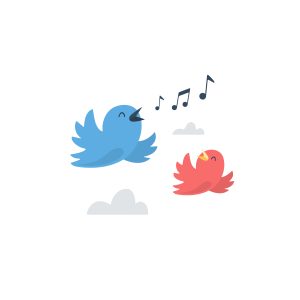 Tweet nicely to the Twitter bot, “LnH: The Band”—a newcomer in artificial intelligence music generation—and the bot will automatically compose melodies for you. The AI-based band is “currently working on their first album,” according to LnH Music, but who will own the rights and royalties to the album? Or what about Mubert, which is touted by its creators as the world’s first online music composer, and which “continuously produces music in real-time … based on the laws of musical theory, mathematics and creative experience?” In other words, if a computer program generates a creative work—be it a song, book or other creation—is there a copyright to be owned? If so, who owns and gets to collect on the copyright?
Tweet nicely to the Twitter bot, “LnH: The Band”—a newcomer in artificial intelligence music generation—and the bot will automatically compose melodies for you. The AI-based band is “currently working on their first album,” according to LnH Music, but who will own the rights and royalties to the album? Or what about Mubert, which is touted by its creators as the world’s first online music composer, and which “continuously produces music in real-time … based on the laws of musical theory, mathematics and creative experience?” In other words, if a computer program generates a creative work—be it a song, book or other creation—is there a copyright to be owned? If so, who owns and gets to collect on the copyright?
The critical question in such instances is whether that “work” is one of human authorship. For example, in the case of an animal-generated work, the answer is clear. When a monkey selfie caused issues for a photographer, the Copyright Office quickly responded by issuing guidance to clarify that “[t]o qualify as a work of ‘authorship’ a work must be created by a human being” and by listing examples of copyright-ineligible works, such as “a photograph taken by a monkey” and “a mural painted by an elephant.” Such animal-generated works belong to the public domain and cannot be owned by any individual or entity. When considering copyright with regard to a computer-generated work, however, the question is whether the work involved human authorship using a machine as a tool or whether the machine “conceived” the creative elements of authorship in the work. In fact, the Congressional Office of Technology Assessment (OTA) indicated decades ago in 1986 that computers could be more than mere tools of creation, even as the agency left open the question of co-authorship between humans and machines for computer‑generated works. That is, although purely mechanized or random processes such as those executed by computers are excluded from copyright protection, a work might still be copyrightable if, for example, a person provided the creative intervention that produced the work.
With the LnH: The Band Twitter bot, for example, a Twitter user can request new compositions by tweeting a message in the specific format: “@lnh_ai [title] /compose /g [genre] /t [tempo] /r [randomness]”. For example, according to LnH Music, “@lnh_ai Dancing robots /compose /g heavy-metal /t 160 /r 0.2” tells the Twitter bot to (1) compose a song with title “Dancing robots” (2) in “heavy-metal” genre (3) with tempo of 160 BPM (4) and randomness of 0.2. There is no doubt that the Twitter bot in the form of a computer program is copyrightable, and the owner of that copyright can be easily determined. Who the author of the bot-generated composition is, however, is a more complicated inquiry. On one hand, many would argue that compositions generated by the Twitter bot in its current iteration might not involve sufficient human creativity for copyright protection; on the other hand, one could imagine how a court may credit a person for such bot-generated compositions, for instance, when the requests that result in generation of the compositions are significantly more complex.
As it stands, the debate surrounding copyright and other intellectual properties for AI-facilitated work is just getting started. In the meantime, the music made—and the legal issues surrounding it—will continue to become more complex as artificial intelligence itself evolves.
 Internet & Social Media Law Blog
Internet & Social Media Law Blog


